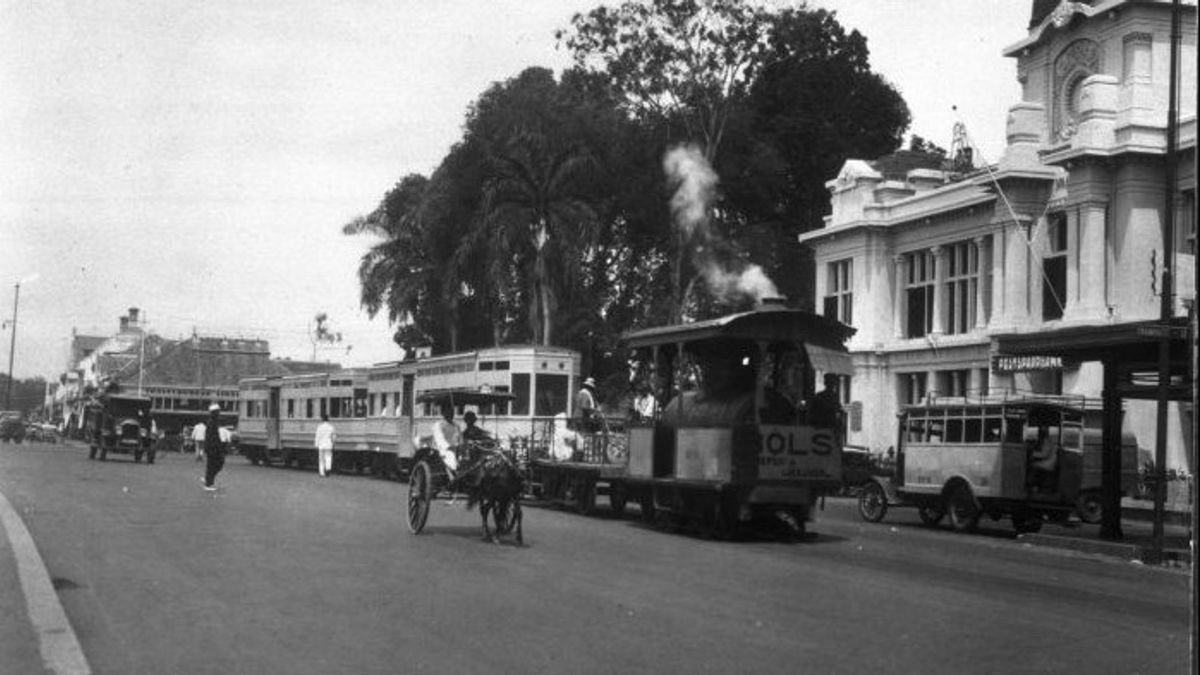JAKARTA - Since long time ago, Jakarta has always been the most advanced in terms of mass transportation. Hundreds of years ago, since Jakarta was still colonized by the Dutch, Jakarta already had a distinctive mass transportation: horse trams, which at that time were the prima donna throughout the capital.
The horse tram in Batavia was based on the idea of an Indo-Dutch citizen, Mr. J Babut du Mares. Described in the Java Bode daily published in December 1860, at that time Mares saw the limitations of mass transportation in the capital city. And horse trams, are the solution in his eyes.
The idea of mares reached the ears of the colonial government. Not playing games, they, the companies with high seriousness in realizing the plan to procure horse trams. Dummler & Co. which is also known as the Bataviasche Tramweg Maatshappij (BTM) has the mandate to build and operate trams in Batavia.
Quoted by Zeffry Alkatiri in Gambir Market, Chinese Comic & Es Shanghai: The Melik Side of Jakarta 1970s (2010), besides Mares, another Dutchman named Martinus Petrus who is also the founder of Dummler & Co. took part in the Batavia dream project. Through his company, the horse tram was built on August 10, 1867. Petrus believed that the Horse Tram would be transformed into an effective, efficient, fast, and cheap mass transportation.
Uniquely, the materials for the construction of trams and their tracks are not only produced in the Netherlands or Java. The Company also involved factories in France to bring in materials. Slowly, the horse tram was inaugurated in Batavia on April 20, 1869.
Meanwhile, the horses were imported from various regions in the archipelago, starting from Sumba, Tapanuli, Sumbawa, Priangan, to Makassar. The horses were used to tow tramcars on tracks which were 1,188 millimeters wide. He explained that it took three horses to pull the carriage with a capacity of 40 passengers.
At that time, the route from the horse tram was held from Amsterdam Poort (Intan City) -Binne Nieuwpoort Straat (Pintu Besar Utara Street) -Molenvliet (Jalan Gajah Mada-Hayam Wuruk) and ended at Harmoni. Due to the high demand, the route was then developed - two months after it was inaugurated - from Harmoni to Tanah Abang, Harmoni-Rijswijk (Jalan Veteran) -Kramat, and ending at Meester Cornelis (Jatinegara).
Instantly, the horse tram won the hearts of the Batavian residents. Because of its popularity, residents who lived at that time were always ringing with trumpets when horse trams came across the streets of Batavia. For them, the sound was not only a sign of a horse tram, but also a sign of progress.
"If at that time we heard trumpets in the middle of a city crowd, please understand. This sound came from a horse carriage. Because the coachman uses a trumpet instead of a horn. The fare is also not expensive. Each route is only 10 cents in order to reach the wider community. Whenever a passenger gets off, the ticket seller rings a bell. Heard the chimes. The driver will rotate a device such as a compass that functions as a brake, "said Alwi Shahab in the book Waktu Holland Mabuklah Batavia (2013).
TroubledEven so popular, the existence of horse trams also provokes many problems. The biggest problem is cleanliness. Of course. The horses can poop and pee wherever they want. The streets were filled with dirt and its strong aroma.
In addition, the problem was exacerbated by the number of horse deaths. The daily Java Bode also highlighted this in an 1872 review. According to reports, 545 horses died.
"Among other things caused by fatigue. In fact, there is a provision that these animals are only allowed to pull the tram no more than once per route, ”said Alwi Shahab, an important figure in the writing of Jakarta's history.
Other problems are poor financial management and racism. As a low-cost public transportation, horse trams can be used by anyone. On the horse tram, the Batavian community mixed. However, this turned out to be a problem for Europeans.

They feel that their dignity is humiliated because they have to share a tram roof with the native people and people of other races. Understandably, that day the Europeans still felt that they were the number one citizen in Batavia who had to be prioritized in all matters.
The Europeans finally stopped using the horse tram. That is what made the Company stop operating horse trams in 1881.

Instead, the Company introduced a steam tram in 1887. The presence of a steam tram was the end of the story of the horse tram era, known as the iron bite era.
“In 1887 the horse tram was retired and replaced with the Steam tram. Steam tram from Senen to Kota, stops at Tanah Abang. On the way back, this tram always transports wet fish from the Monday Market, "said Tota M. Tobing in an article entitled Tanah Abang History in the book" Ketoprak Jakarta "(2001).
The English, Chinese, Japanese, Arabic, and French versions are automatically generated by the AI. So there may still be inaccuracies in translating, please always see Indonesian as our main language. (system supported by DigitalSiber.id)











